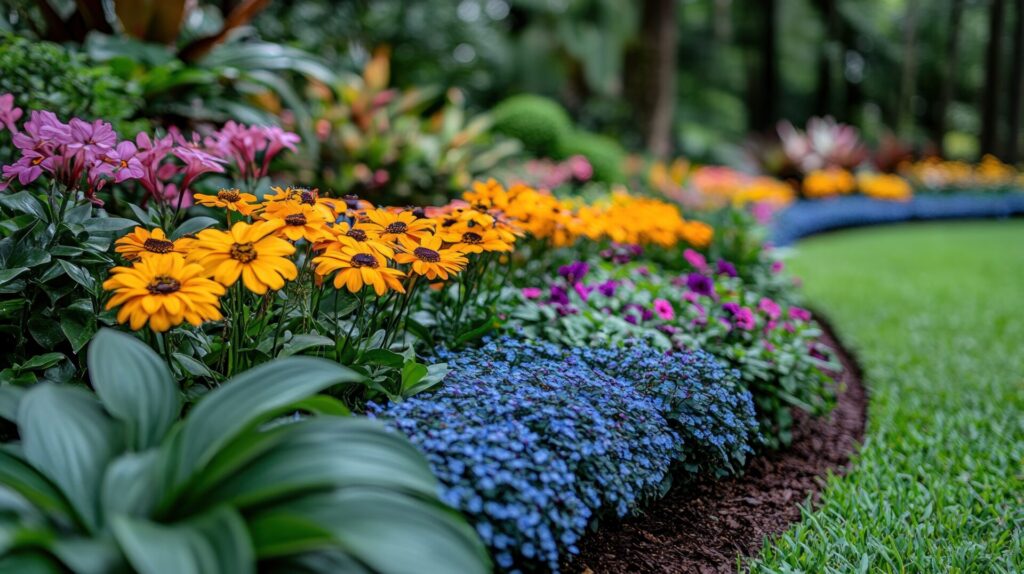As the intense summer heat fades, fall offers ideal conditions for moving and dividing perennials. Cooler temperatures and steady rainfall ease transplant shock, giving roots a better chance to establish before the ground freezes. It’s also the best time to divide and move overcrowded or declining perennials. Giving them space encourages healthier growth, improves air circulation, and minimizes nutrient competition.
With proper timing and method, fall transplanting perennials enhances plant health and ensures a stronger, more consistent start in spring.
Signs Your Perennials Need Transplanting
Not all perennials require moving, but several indicators suggest it’s time:
- Sparse or dead centers: When the center becomes thin or hollow while the edges remain active, the plant is likely overcrowded and needs division to maintain even growth.
- Smaller or fewer blooms: A noticeable drop in flower production typically indicates stressed or restricted roots struggling to absorb nutrients. Moving the plant to a well-prepared area can improve flowering and overall vigor.
- Overgrown space: If the plant begins to crowd neighboring species or reach into walkways, it’s a good time to relocate it to maintain order and spacing.
- Visible or circling roots: Exposed roots or tightly wrapped roots indicate the plant has outgrown its space. Transplanting helps prevent water stress and nutrient competition.
Step-By-Step Guide To Fall Transplanting Perennials
Follow these steps to transplant effectively:
1. Plan and Prepare
Begin by selecting a location that meets the plant’s light, soil, and space needs. Clear the area of weeds, rocks, or leftover mulch and loosen the soil at least 10–12 inches deep using a shovel or garden fork. This helps reduce compaction and makes it easier for new roots to grow. If the soil is dry, water it a day before transplanting.
2. Dig up the Perennial
Using a sharp spade, cut a wide circle several inches beyond the outer foliage to preserve as many roots as possible. Dig deep to reach below the main root mass, keeping the root ball intact to limit stress.
3. Lift the Plant Carefully
After loosening the root ball, slide a shovel or garden fork underneath and gently lift the plant from the ground. Support the base of the plant with one hand while stabilizing the soil mass with the other. Avoid lifting by the stems or foliage, which can snap under pressure.
4. Divide if Needed
If the plant shows crowding, like a hollow center or fewer blooms, use a clean knife to divide the root ball into smaller clumps. Each section should have healthy roots and at least three to five strong shoots. Trim off any dead material before replanting.
5. Plant in the New Location
Dig a new hole that’s twice as wide as the root ball but no deeper. Gently position the plant so its crown — where the roots meet the stem — sits level with the surrounding soil. Backfill with native soil, firming gently as you go to eliminate air gaps. Avoid burying the crown too deep, which can lead to rot.
6. Water Immediately
After planting, water deeply to help settle the soil and reduce air pockets around the roots. Continue watering consistently, especially during dry spells, until the ground freezes.
7. Mulch the Area
Finish with a 2–3 inch layer of mulch, such as shredded bark or compost. Mulch helps retain moisture, regulates soil temperature, and shields roots from early frost. Keep it a few inches away from the crown to prevent fungal issues.
Caring for Transplanted Perennials
Proper care after transplanting supports root recovery and survival through winter. Here are some tips:
- Water regularly. Keep the soil evenly moist until the ground freezes. Also, check moisture levels regularly, especially during dry periods.
- Avoid fertilizing immediately. Fertilizer encourages top growth that’s vulnerable to cold and draws energy away from root establishment.
- Protect from early frost. If frost arrives before roots are established, cover plants with burlap or frost cloth overnight to reduce stress.
- Monitor for pests and diseases. Transplanted plants are more vulnerable. Inspect leaves and stems regularly, and address issues promptly.
Trust Well Rooted Gardens for Fall Planting Expertise and Care
Fall transplanting perennials requires proper timing, careful handling, and the right techniques to ensure long-term plant health. With over 15 years of serving Omaha and surrounding areas, Well Rooted Gardens applies region-specific expertise to every project. We source quality perennials from licensed nurseries and plant with attention to mature size, root growth, and site conditions to promote healthy development.
Call 402-800-7389 or contact us to learn more!

